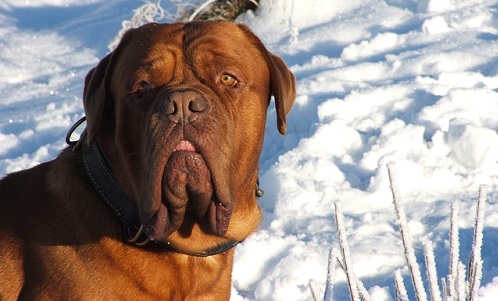We all have that fateful canine question. No matter how much we love a dog or an entire breed, we are bound to wonder one thing…how much do they shed?
This certainly applies to a beloved breed of big dog, the Mastiff.
What Type of Coat Does a Mastiff Have?
Fun Fact: Mastiffs are one the oldest dog breeds. Their dog ancestors go back to a whole 5,000 years ago.
From then until now, their fur has remained a medium to short coat.
The good news about this: It means your dog will dry quickly after having a bath!
The bad news: There is indeed massive mastiff shedding.
So…Do Mastiffs Shed?
 Yes, my friend, congratulations if you’re already an owner. Mastiffs shed between moderate to heavy.
Yes, my friend, congratulations if you’re already an owner. Mastiffs shed between moderate to heavy.
Even though shedding may worsen or lessen depending on the season, they are still known to shed all year-round.
As is common with many breeds of dog, many mastiffs predominantly shed during two seasons: summer and fall. Depending on your location and weather, this may vary or shift.
And, remember this: The grand size of the mastiff means there is just that much more hair to shed.
Here is how the Mastiff shedding process works: Each hair grows to a certain length; once it reaches that point, the hair then makes like an autumn leaf and falls off. This cycle of hair happens throughout the 365 day calendar year.
Luckily, there are techniques to mitigate your pet’s shedding!
For example, their level of shedding does correlate with the level they are brushed. That means the more your brush, the less they will shed.
Brushing Helps with Mastiff Shedding
Just as humans with long hair brush their hair to keep it smooth and remove any debris, it is important to brush your beautiful canine as well.
- Use a good dog brush to brush them thoroughly; this helps to trap and gather hairs before they spread around your home.
- It is recommended to use a rubber curry brush or even a shedding blade while grooming your dog.
- Frequency: Brush at least once per week or even once per day.
- Do not only brush in one direction. Try using a circular technique to help get deeper into the fur and access the undercoat.
Bath Techniques to Reduce Shedding
The way you bathe your Mastiff will also aid in treating his shedding. Here are tips for bathing your mastiff:
- Give your pup a luscious bath at least once per month.
- When bathing him, use warm water because it will help to loosen up all that fur and hair.
- During the bathing process, it helps to use a great conditioner in addition to gentle dog shampoo.
- After the bath, brush your dog thoroughly. This is like a spa experience for them; they enjoy the brushing as if it were a massage!
Get a Specialized Deshedding Product
 Many Mastiff owners rave about tools that are specially made for high-shedding dogs. One commonly praised tool is an undercoat de-shedding tool. These products help to get past the topcoat and remove fur from the sneaky undercoat at a deeper level.
Many Mastiff owners rave about tools that are specially made for high-shedding dogs. One commonly praised tool is an undercoat de-shedding tool. These products help to get past the topcoat and remove fur from the sneaky undercoat at a deeper level.
Before using any such product, do consult with your certified vet to make sure it is the right tool and for how much to use it. Overuse of such a tool can also cause irritation to a dog’s skin.
Incorporate Oils to Reduce Mastiff Shedding
Some dog owners swear by adding certain ingredients to their dog’s diet to help with shed control, such as flaxseed oil or pure salmon oil.
Please consult with your vet before making any changes to your dog’s diet. If your vet confirms that it is okay to try adding oils or supplements to your dog’s diet, work them in slowly and monitor your pup carefully.
What If You Have Allergies?
To be candid, the noted skin conditions in dogs, shedding, and quite a large amount of drooling mean the Mastiff is not a great candidate for those with allergies. If you already have and adore the wrinkly face of your beloved Mastiff, follow the strategies above and see if these tips help when your allergies begin to flare.
Hopefully, the right brushing, bathing techniques, and diet changes can be the difference in the level of sneezing and red, itchy eyes.




